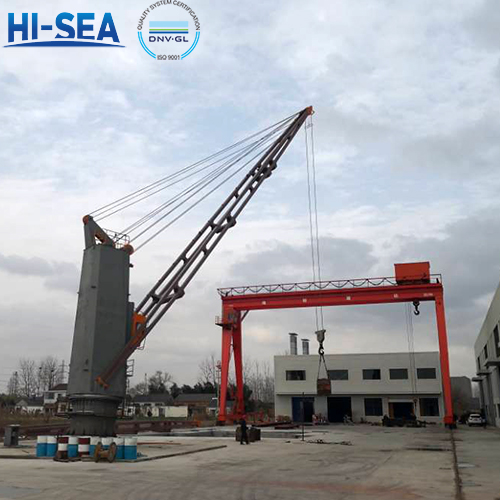
Test requirements for marine crane
According to the "Technical Rules for Statutory Inspection of Lifting Equipment" (1999) issued by the China Shipyard Inspection Bureau, the main requirements for the testing of slewing cargo cranes (cranes) are as follows: (1)Each crane or suspension rod should be tested according to the test load specified in the table below, and the test procedure should be approved by the ship inspection department. The boom should be placed at the maximum boom position specified on the design drawings. The test should use heavy objects with quality certificates, and the hanging time of the heavy object after lifting off the deck should not be less than 5 minutes. If it is not feasible to lift all the test loads with a hydraulic crane, the test load test can be reduced, but it should not be less than 1.1 times the safe working load.
Overview
According to the "Technical Rules for Statutory Inspection of Lifting Equipment" (1999) issued by the China Shipyard Inspection Bureau, the main requirements for the testing of slewing cargo cranes (cranes) are as follows:
(1) Each crane or suspension rod should be tested according to the test load specified in the table below, and the test procedure should be approved by the ship inspection department. The boom should be placed at the maximum boom position specified on the design drawings. The test should use heavy objects with quality certificates, and the hanging time of the heavy object after lifting off the deck should not be less than 5 minutes. If it is not feasible to lift all the test loads with a hydraulic crane, the test load test can be reduced, but it should not be less than 1.1 times the safe working load.
Test load of slewing crane | |||
Safe working load SWL (T/kN) | Testing load (T/kN) | Safe working load SWL (T/kN) | Testing load (T/kN) |
≤20(196) | 1.25×SWL | SWL>50 | 1.1S×SWL |
10(196)>SWL≤50(490) | SWL+5(49) | ||
(2) The crane should be lifted at a slow speed under the test load, tested for amplitude variation according to the designed working angle, and tested for rotation according to the designed limit angle at the lowest design amplitude. At the same time, corresponding braking tests should also be carried out. A walking crane should still undergo a slow-range walking test under the test load.
(3) The crane with different arm amplitudes and corresponding safety working loads should generally undergo corresponding load tests at different arm amplitudes. If the experience ship department agrees, the test load of the intermediate arm amplitude test can be reduced.
(4) Action tests should be conducted on overload protection devices and torque protection devices, and load indicators should be verified.
For more marine crane information, kindly please click here.





